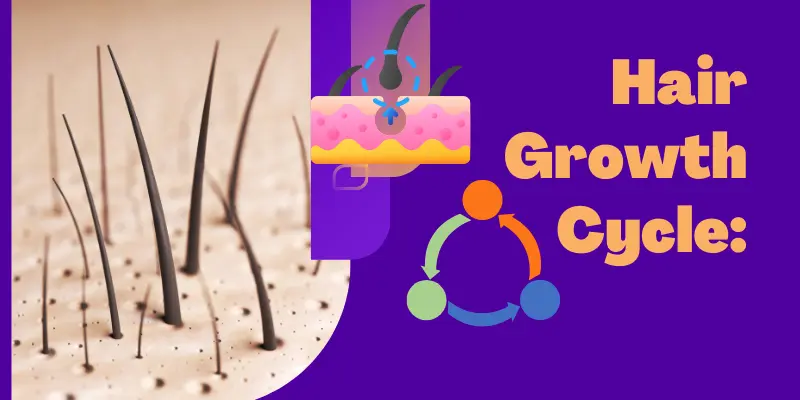How Many Hairs Are on the Human Head? Exploring Hair Density & Growth Facts
Published: 11 Dec 2024
Have you ever stopped to wonder: How many hairs are on your head? This simple question leads to a fascinating dive into hair science. Most people have between 80,000 and 150,000 strands on their scalp. But why the wide range? The answer lies in your hair color, genetics, age, and health. This article is crafted for readers aged 15 to 45, especially those curious about hair density, hair growth cycles, and scalp care. Whether you’re a teen exploring your hair type or an adult noticing changes, this guide meets your needs with facts, tips, and stories you’ll relate to.
The Average Hair Count by Color
Did you know that your hair color plays a role in how many strands you have? Here’s a quick breakdown:
- Blonde hair: 120,000-150,000 strands
- Brown hair: 100,000-120,000 strands
- Black hair: 100,000-110,000 strands
- Red hair: 80,000-90,000 strands
Blondes tend to have more hair strands because their hair is usually finer. Redheads, on the other hand, often have fewer strands, but their hair is thicker — a natural clue to the Secret to Thicker Hair that lies in texture, not quantity.
What Affects Hair Count and Density?
Several factors affect hair count and density, including genetics, age, hormonal changes, diet, stress levels, and overall scalp health.

Several factors affect hair count and density, including genetics, age, hormonal changes, diet, stress levels, and overall scalp health.
1. Hair Type
Fine hair allows for more strands to grow in a given area. Coarse or thick hair takes up more space per strand, resulting in fewer follicles on the scalp.
2. Genetics
If your parents have dense, thick hair, there’s a good chance you will too. Genetics play a huge role in determining how many hair follicles you have.
3. Age
As we age, the number of active follicles naturally decreases. Thinning hair is more common in people over 40.
4. Hormones
Hormonal changes, such as during puberty, pregnancy, or menopause, can influence hair density. Men may experience pattern baldness due to androgens.
5. Diet and Nutrition
A healthy scalp needs proper nutrition. Deficiencies in biotin, iron, and zinc can lead to hair loss. A balanced diet supports growth and thickness.
The Hair Growth Cycle
The hair growth cycle consists of three main phases: anagen (growth), catagen (transition), and telogen (resting). Each strand of hair goes through this cycle independently, which determines how long your hair grows and when it sheds.

Understanding this process is key to managing hair health and promoting consistent growth. Hair doesn’t grow continuously — each strand follows a 3-phase cycle, and knowing this is essential when exploring effective hair growth tips.
Anagen (Growth Phase)
Lasts 2-6 years. About 85-90% of your hair is in this phase at any time. Hair actively grows about 0.5 inches (1.25 cm) per month.
Catagen (Transition Phase)
Lasts 2-3 weeks. This is a short resting period where growth slows down and the follicle shrinks.
Telogen (Resting Phase)
Lasts 3-4 months. Hair stops growing and eventually falls out. About 10-15% of your hair is in this phase.
On average, people shed 50 to 100 hairs daily. This is normal and part of the cycle.
Personal Story: When I Noticed Hair Thinning
At 28, I noticed my ponytail getting thinner. I wasn’t losing handfuls, but the change was visible. A dermatologist told me stress and a poor diet were causing it. I added more leafy greens and iron-rich foods to my meals and began scalp massages. Within a few months, my hair looked fuller, and I felt better.
Surprising Hair Facts
- Growth Rate: About 6 inches per year.
- Coverage: 100,000 hairs can cover around 10 square feet of scalp.
- Strength: A single strand can hold up to 100 grams. That means your full head of hair could hold the weight of two small elephants!
- Life Span: Hair can grow continuously for 2 to 7 years, depending on your health and genes.
Tips to Maintain Healthy Hair Density
Here are some tips to maintain healthy hair density:
Balanced Diet
Include foods rich in biotin, iron, and omega-3 fatty acids to boost hair strength and thickness.
Avoid Over-Styling
Limit heat tools, tight hairstyles, and chemical treatments. These damage follicles and weaken strands.
Choose Gentle Hair Products
Go for sulfate-free shampoos and conditioners. Harsh chemicals dry out your scalp and lead to breakage.
Scalp Massage
Daily scalp massages increase blood circulation and help deliver nutrients to hair roots.
Manage Stress
Chronic stress can disturb your hair cycle. Practice relaxation techniques like meditation, deep breathing, or yoga.
Tricks for Hair Care (I Learned from My Mom)
My mom has always had thick, beautiful black hair- seriously, the kind you notice from across the room. Growing up, she would always say, “Oil your hair every week, and never skip your hair masks.”

Like most of us in our twenties, I ignored that advice. I was too busy, too modern, so I thought. But after experiencing severe breakage and thinning, I found myself going back to her old, trusted routine.
Now, I massage coconut oil into my scalp every weekend. It not only improves shine but also supports hair density and thickness. I’ve even started using her favorite DIY hair mask every two weeks. It’s made with aloe vera, egg, honey, and yogurt, all kitchen staples. After just a few uses, my hair felt softer, fuller, and stronger.
This simple return to tradition, backed by ingredients my mom trusted, has made a real difference in how my hair looks and feels. Trust me, sometimes “Mom knows best” is more than just a saying; it’s the key to beautiful, dense hair.
Conclusion:
Hair density is more than just a number- it reflects your hair’s health, genetics, and care. Whether you have thick, medium, or fine density, learning about your hair’s natural structure helps you choose the right products, styles, and treatments. From knowing how many hairs are on the human head to what affects their growth, you now have the knowledge to care for your scalp and strands better. Remember, healthy hair starts from within, so nourish your body, stay gentle with your hair, and celebrate your unique density.
FAQs
The number of hairs on a human head usually ranges between 80,000 and 150,000. Genetics, natural hair color, and scalp health play a big role in this variation. People with finer hair tend to have more strands, while those with thicker strands often have fewer overall. Regardless of count, proper scalp care helps maintain fullness and hair longevity.
Yes, natural hair color does influence how many strands you have. Blondes usually have the highest number, averaging around 150,000 strands, but their hair tends to be finer. Redheads typically have fewer strands, closer to 80,000, but each strand is much thicker. Brunettes and people with black hair usually fall in between these numbers.
On average, hair grows about half an inch per month, which equals roughly six inches per year. However, this can vary depending on genetics, overall health, and age. Factors like stress, diet, and hormonal balance can either speed up or slow down this natural growth cycle. Proper scalp care also helps maintain consistent growth.
It’s normal to shed between 50 and 100 hairs per day as part of the hair’s natural cycle. These strands usually fall out during washing, brushing, or simply moving throughout the day. Shedding above this range may signal issues like stress, nutritional deficiencies, or medical conditions. Monitoring shedding patterns can help catch problems early.
No, the number of hair follicles you’re born with is permanent and cannot increase. However, you can improve the thickness and health of the existing follicles through good care. Proper nutrition, hydration, and scalp stimulation can encourage stronger, healthier growth. Treatments may also help reactivate dormant follicles if caught early.
Yes, hair density naturally decreases with age due to shrinking or inactive follicles. This often results in thinner hair, slower growth, and more visible scalp areas. Hormonal changes, stress, and lifestyle factors can speed up this process. Consistent scalp care and healthy living can help slow age-related thinning.
Maintaining a balanced diet rich in vitamins, minerals, and proteins supports hair density. Regular scalp massages can boost circulation, which helps deliver nutrients to the follicles. Reducing stress through lifestyle changes like exercise and mindfulness also prevents unnecessary shedding. Avoiding harsh treatments or excessive heat styling preserves density over time.
Absolutely, hormones play a key role in the hair growth cycle. For example, imbalances in thyroid hormones, testosterone, or estrogen can cause thinning or excessive shedding. Conditions like PCOS or postpartum changes also affect hair density and texture. Balancing hormones through medical care can significantly improve hair health.
The strength of hair comes from keratin, a durable protein that forms the hair shaft. Despite its fine appearance, a single strand of hair can support surprising weight. This protein structure makes hair resistant to wear but also prone to damage from chemicals and heat. Proper care helps maintain keratin’s strength and resilience.
While you may not be able to completely prevent thinning, you can slow it down with the right habits. Early treatment, gentle styling, and nourishing products protect existing hair. Maintaining a healthy diet and managing stress also helps preserve density. Paying attention to early signs of thinning gives you the best chance of control.

- Be Respectful
- Stay Relevant
- Stay Positive
- True Feedback
- Encourage Discussion
- Avoid Spamming
- No Fake News
- Don't Copy-Paste
- No Personal Attacks

- Be Respectful
- Stay Relevant
- Stay Positive
- True Feedback
- Encourage Discussion
- Avoid Spamming
- No Fake News
- Don't Copy-Paste
- No Personal Attacks





